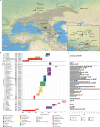Emergence and intensification of dairying in the Caucasus and Eurasian steppes
- PMID: 35393601
- PMCID: PMC9177415
- DOI: 10.1038/s41559-022-01701-6
Emergence and intensification of dairying in the Caucasus and Eurasian steppes
Abstract
Archaeological and archaeogenetic evidence points to the Pontic-Caspian steppe zone between the Caucasus and the Black Sea as the crucible from which the earliest steppe pastoralist societies arose and spread, ultimately influencing populations from Europe to Inner Asia. However, little is known about their economic foundations and the factors that may have contributed to their extensive mobility. Here, we investigate dietary proteins within the dental calculus proteomes of 45 individuals spanning the Neolithic to Greco-Roman periods in the Pontic-Caspian Steppe and neighbouring South Caucasus, Oka-Volga-Don and East Urals regions. We find that sheep dairying accompanies the earliest forms of Eneolithic pastoralism in the North Caucasus. During the fourth millennium BC, Maykop and early Yamnaya populations also focused dairying exclusively on sheep while reserving cattle for traction and other purposes. We observe a breakdown in livestock specialization and an economic diversification of dairy herds coinciding with aridification during the subsequent late Yamnaya and North Caucasus Culture phases, followed by severe climate deterioration during the Catacomb and Lola periods. The need for additional pastures to support these herds may have driven the heightened mobility of the Middle and Late Bronze Age periods. Following a hiatus of more than 500 years, the North Caucasian steppe was repopulated by Early Iron Age societies with a broad mobile dairy economy, including a new focus on horse milking.
© 2022. The Author(s).
Conflict of interest statement
The authors declare no competing interests.
Figures



References
-
- Evershed RP, et al. Earliest date for milk use in the Near East and southeastern Europe linked to cattle herding. Nature. 2008;455:528–531. - PubMed
-
- Salque M, et al. Earliest evidence for cheese making in the sixth millennium bc in northern Europe. Nature. 2013;493:522–525. - PubMed
-
- Dunne J, et al. First dairying in green Saharan Africa in the fifth millennium bc. Nature. 2012;486:390–394. - PubMed
Publication types
MeSH terms
LinkOut - more resources
Full Text Sources

